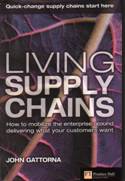To succeed in today’s hypercompetitive environment, you must have a living, dynamically aligned supply chain.
So says the extremely interesting Dr. John Gattorna, of the Sydney Business School (Australia) and Cranfield School of Management (UK).
I had the pleasure of hearing and interviewing Dr. Gattorna at the recent CSCMP conference, where he spoke on supply chain collaboration (we’ll air our video interview very soon). The CSCMP presentation was largely based on Gattorna’s new book, Living Supply Chains, which I’ve just read. 
This is a provocative book, with a quote about every other page that has you reaching for the highlighter. Just one example: The extreme corporate focus on getting lean supply chains and cutting costs “almost always brings on a bout of anorexia industrialosa, the excessive desire to be leaner and fitter, leading ultimately to total emaciation and death.”
Makes you chuckle, but in part because of the strong truth to the idea demonstrated by many companies.
This will have to be a two-parter, because I can’t possibly do justice to the full force of the contents here in one column. I also have some questions on areas that I think need clarification, but whether you agree wholeheartedly with the positions taken by Gattorna or not, they will certainly cause you to think about how your supply chain really works.
Why is a supply chain living? In part, because in the end, it isn’t driven by networks and assets and technology, but by people. Somehow, too many of us tend to lose sight of that. “The reality is that it is people who drive the supply chain, both inside and outside your business, not hard assets or technology,” Gattorna writes. “They are in fact living systems, propelled by humans and human behavior.”
It is the failure to understand that human element, or indeed the lack any real body of knowledge in this area of supply chain, that is a major force in why some many strategies go unrealized, and many efforts at collaboration produce little value. Harnessing that dimension is the next and only real source of competitive advantage. “If you can understand and correctly apply a more enlightened approach to managing this ‘human factor’ in the supply chain, you’ll discover a primary source of performance improvement. It’s all there for the taking.”
So when you start thinking about improving your supply chain, remember the 45-45-10 rule: success is dependent 45% on people, 45% on systems (because they should help drive human decision-making) and just 10% infrastructure, says Gattorna.
I think that last point is true, however, once you’ve done some level of “network optimization,” as I agree with those who argue that a huge preponderance of a supply chain’s costs are locked-in based on your supply chain design.
Ah, but supply chain design – now there’s the problem, according to Gattorna. The functional nature of how we organize are supply chains, and the misalignment both internally and with customer requirements is the root cause of excessive supply chain cost, supply chain complexity, and ultimately challenges in growing revenues and profitability.
Because of how we are organized, we often have literally hundreds of supply chains running through the business. The complexity of these many supply chains and “interfaces” between internal functions and external suppliers and customers in fact makes the true supply chain largely invisible even to those responsible for managing them. “Value is either created or destroyed through the management of these interfaces along the chain or network.”
In the space I have left for part 1 of this review and comment, I’ll get to the main point of the book: Our strategies for customer segmentation, and how we align our supply chains with those segments, are all wrong. It is this misalignment that leads to over-servicing many customers, and under-serving others – and we usually don’t know which is which. The only right way to segment customers is by their buying behavior, of which there are generally only three or four main types (though customers can move between types over time or for a period of time). While many SCM pundits have discussed crafting differentiated supply chain strategies, Gattorna argues most have focused too heavily on either product characteristics or channel segments (e.g. retail, wholesale, industrial, etc.).
The best way to segment customers is based on needs for service, price, consistency, uniqueness, innovation and other attributes – and to consider that holistically, from both a marketing and supply chain strategy. Unique supply chains – and supply chain teams – must be developed for each segment, and in today’s market, you probably have to serve nearly all of these segments.
I think the customer logistics teams now deployed by most large CPG companies are actually quite close to this concept, at least from the customer interface and some execution elements, but they have generally only been deployed for a few large retailers.
When you organize like this, you have people and supply chains focused on delivering very closely to what customers want to buy, and they get very good at serving that type of customer. You align costs, service and pricing in a way that reduces dramatically under and over service. You only spend time and effort at collaboration with those customers that really want to and value collaboration. These supply chains and where customers fit must be dynamically (frequently) aligned - in other words, "living."
A typical segmentation of both the market and the supply chain might then look something like this:

I realize that was a whirlwind tour, but we’ll have more from Living Supply Chains in a few weeks.
Do we over and under service too many customers – and often not even know which is which? Why is that? Should we – and can we – develop differentiated supply chains and teams based on customer buying behaviors? And is managing the human element that missing key to supply chain success and competitive advantage? |
![]()
